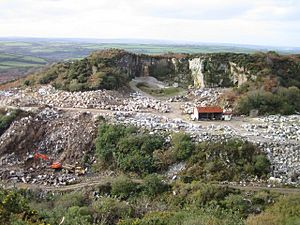De Lank Quarries facts for kids
De Lank Quarries is a special place in north Cornwall, England. It covers about 54 acres and is known for its high-quality granite. This area is so important for its geology that it's been named a Site of Special Scientific Interest (SSSI). This means it's protected because of its unique natural features. The quarry gets its name from the nearby De Lank River.
Contents
De Lank Quarries: A Source of Strong Stone
De Lank Quarries produces a type of rock called granite. This granite is known for being very strong and beautiful. It's so good that a large piece of it is used as the base of the reception desk at the Geological Society of London.
What is Granite?
Granite is a very hard and tough rock. It forms deep underground when molten rock (magma) cools down slowly. This slow cooling allows large crystals to grow, which gives granite its speckled look. The granite from De Lank Quarries is a specific type called biotite granite. It's often used in buildings because it lasts a long time and looks good.
Famous Buildings Made from De Lank Granite
The strong granite from De Lank Quarries has been used in many important structures.
- The fourth Eddystone Lighthouse, built in 1882, used De Lank granite. Lighthouses need to be very strong to stand up to ocean storms.
- The Royal Opera House in Covent Garden, London, also features this granite.
- The New Parliamentary Building in Whitehall, London, is another famous structure built with De Lank granite. This shows how valued the stone is for important public buildings.
Moving the Granite: The Railway Connection
To get the heavy granite from the quarry to building sites, a special railway line was used. A branch of the Bodmin and Wadebridge Railway served the De Lank quarry. This railway helped transport the large blocks of stone, making it possible to use them in buildings far away.


